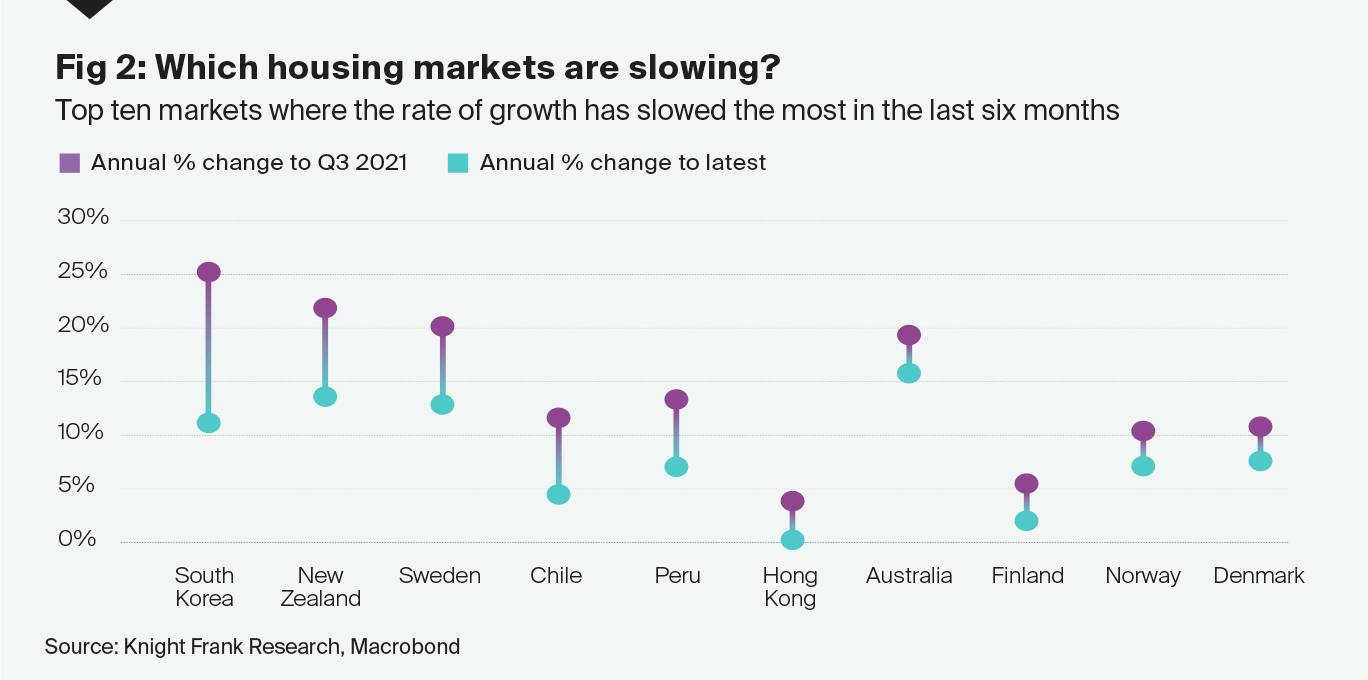Half of the world's housing markets still seeing double-digit growth, for now
Making sense of the latest trends in property and economics from around the globe
5 minutes to read
Rate hikes
The Bank of England and the US Federal Reserve are overwhelmingly likely to hike their key interest rates this week, but by how much?
The Fed has "all but promised" a half a point jump both this week and at its next meeting in July, which will further dampen housing market activity as borrowing costs rise. The average 30-year mortgage rate sat at 5.2% at the end of last week, from a little over 3% in December, according to Freddie Mac. Existing home sales dropped to the lowest level in two years last month.
A hike on Thursday would make it five in a row for the Bank of England, though any move is likely to come in at 0.25%. That would bring the base rate to 1.25%. Like the US, the housing market is beginning to cool - see Friday's note. New UK buyer enquiries fell into negative territory following eight months of positive readings last month and came back flat or negative in nine of the twelve regions, according to the latest RICS residential market survey.
Meanwhile, economic UK output shrank 0.3% in April after contracting 0.1% in March, according to official figures out this morning. The decline was in part due to the wind down of Test and Trace, but activity in all major sectors fell back. Construction contracted by 0.4%.
The unwinding
Similar patterns are playing out in several housing markets, though explosive rates of growth take time to unwind.
On an annual basis, house prices are declining in just two of the 56 we track in our Global House Price Index - Malaysia and Morocco. Almost half are still registering double-digit price growth.
The chart below offers some perspective on the pace of cooling in various markets during the most recent six months. Australia, New Zealand and Canada are all in the process of tightening monetary policy and the European Central Bank, which has been famously hesitant so far, is expected to make its first move in eleven years next month.
As Knight Frank Head of International Residential Research Kate Everett-Allen notes this morning, we expect a soft landing in most of these markets due to a mixture of supply constraints, robust household balance-sheets and a greater willingness on the part of homeowners to spend more on their living arrangements following stringent lockdowns.

Brexit
The European Central Bank is engaged in a long-running spat with the Bank of England over banking jobs in the wake of Brexit. Essentially, UK banks can no longer serve EU institutions via "passporting", so staff that relied on it before Brexit would need to move to a member state to continue operating as before.
The ECB concluded a "desk-mapping study" last month that suggested about one in five trading desks “warranted targeted supervisory action,” meaning the ECB thinks they should be located in a member state under its supervision. By all accounts, London-based staff are reluctant to move - see this report in yesterday's Telegraph.
Is the sustained push-back a sign that London's dominance in financial services is so entrenched that it can't be challenged, or is the ECB's persistence all part of the slow puncture for the City of London that commentators have predicted?
It's going to be years before we know - this is going to be a slow, grinding process - but whether its data on jobs or investment, all signs point to the City's enduring resilience. EY this morning published its latest rankings of overseas direct investment into financial services, and the UK retained its top spot, though the gap to France in second place narrowed. Britain was also seen as the most attractive European country for future financial services investment, ahead of Germany in second and France in third.
Recovery mode
The London property market is busy as the capital recovers from the depths of the pandemic and the ‘escape to the country’ trend calms.
The number of new prospective buyers registering last month was the third highest figure in a decade. Supply is finally rising and the number of new sales instructions reached the sixth highest figure in ten years. Robust demand and rising supply means more deals, and the number of offers accepted in May was the highest monthly figure in a decade.
The dynamics are being felt most in Prime central London (PCL), which is in recovery mode after seven subdued years caused by tax rises and political uncertainty. Prices in PCL rose 2.4% in the year to May, which was the highest rate of annual growth since April 2015. International buyers, who haven’t yet returned in meaningful numbers, will only fuel activity further. Here is Tom Bill:
“The stars are aligning for buyers and sellers in the London property market, with supply increasingly able to keep pace with robust demand.”
Meanwhile, the supply and demand imbalance that plagued the sales markets for many months is proving sticky in the prime London rental market. However, there were some early signs of recovery in May. Here's Tom with more on that.
In other news...
Stephen Springham analyses the administration of former darling of the retail sector Missguided, and weighs up the wider implications for the retail sector. Read it here.
Elsewhere - BoE could exceed rate expectations to show it is serious on inflation (FT), SEC investigating Goldman Sachs for ESG claims (FT), ESG funds hit by regulatory reckoning (Bloomberg), new warning from CBI on household spending (Times), and finally, UK faces up to a recession in all but name (Bloomberg).